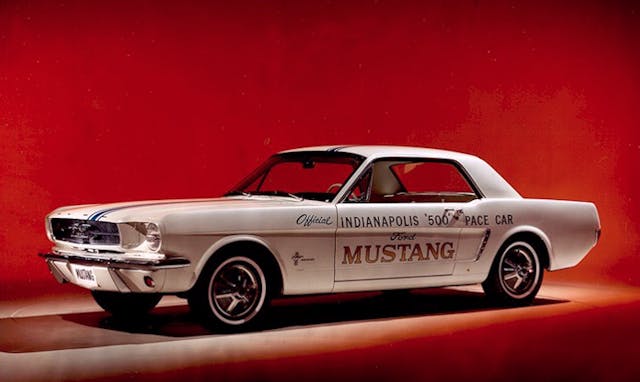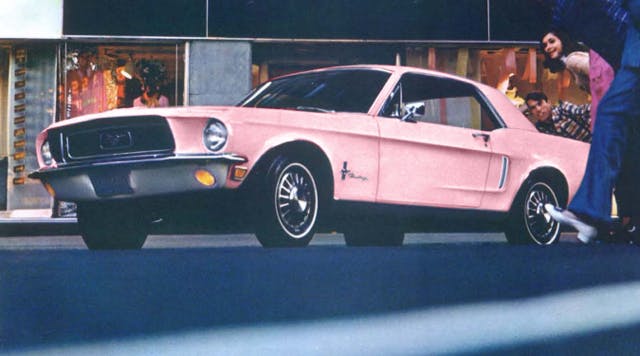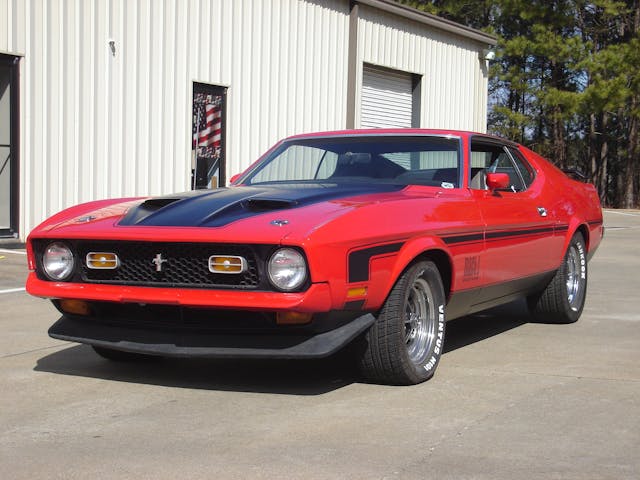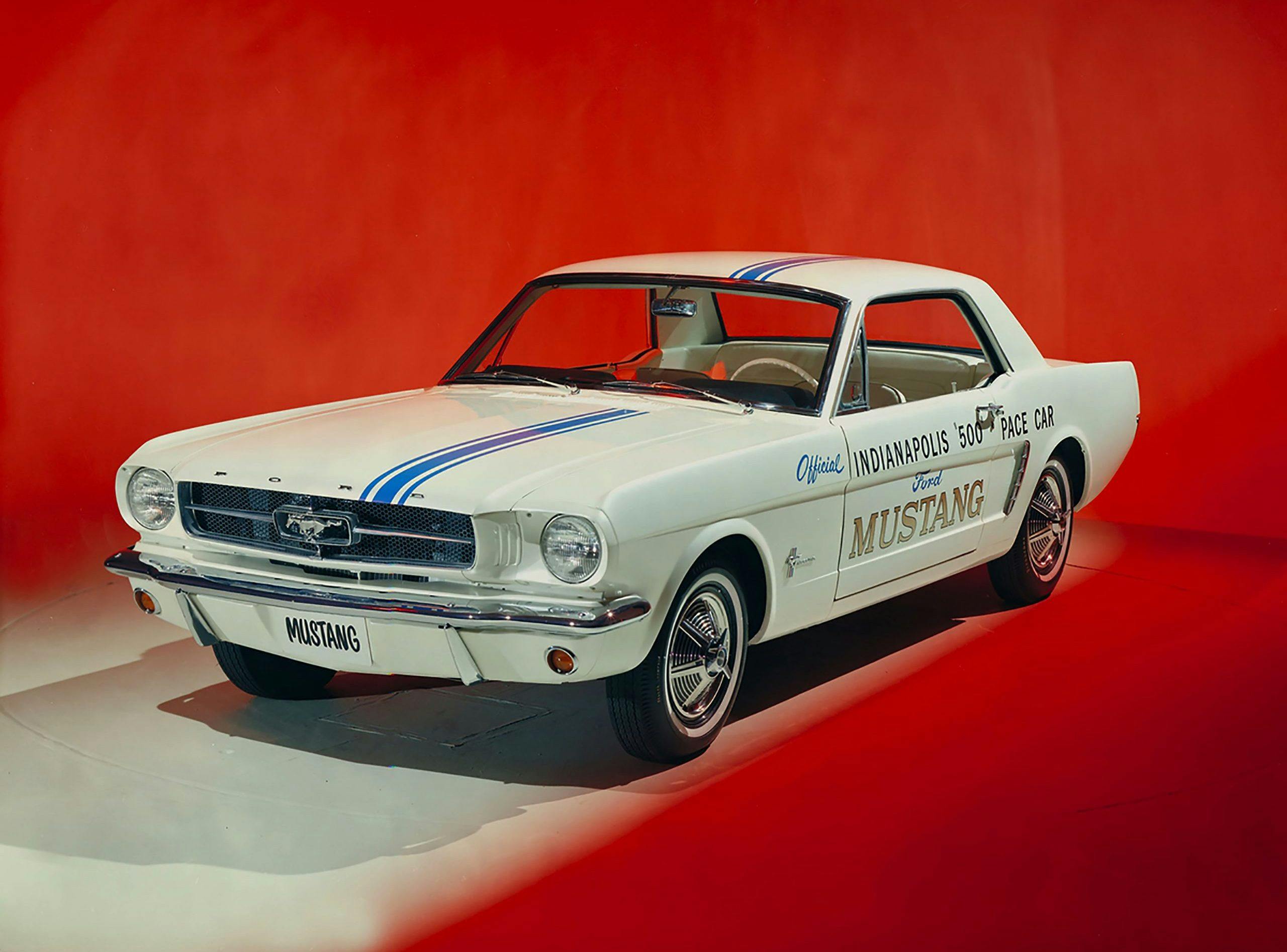Media | Articles
7 lesser-known Mustangs that are surprisingly uncommon
Happy birthday, Mustang! This week you’re 58 years old and aging well, with a redesign scheduled for a year from now. There’s been plenty of great Mustangs throughout your storied history, with Hi-Pos, Cobra Jets, Mach 1s, Bosses, Five-Liters, and Cobras garnering much of the attention.
It’s easy to remember the big names in the Mustang annals, but there are other interesting, lesser-known models that rightfully belong in the lineage. Many are enticingly uncommon, too. Here are seven low-production Mustangs that deserve to be remembered.
1964½ Mustang Indy Pace Car Replica

For all the Mustang’s popularity, this commemorative pace-car replica is somewhat enigmatic. As was common practice, a new and interesting car was selected to pace the Indianapolis 500, and the newly introduced Mustang was the logical choice in 1964. According to pace-car expert Tom Benvie, there were at least 40 white convertibles with various interior colors for dignitaries plus two actual pace cars. However, the pace-car replicas were hardtops complemented by a blue-accented white interior. Each was powered by a 260-cubic-inch, two-barrel V-8 mated to a Cruise-O-Matic transmission. Through his research, Benvie estimates 850 pace car replicas were built, though they were not sold to the public but rather were part of dealer incentive contests, which explains the enigma.
1968 Rainbow of Colors Mustang

If you’re a Mustang fan, you’re probably familiar with the myriad of Mustang promotions, many of them region-specific. One of these was the Rainbow of Colors, which was promoted from February through June of 1968 (there were some 1969s as well) for certain West Coast districts including Salt Lake City, Utah; Los Angeles and San Jose in California; and Honolulu, Hawaii. What made these Mustangs special were the available 13 special-order hues with names like Whipped Cream, Caribbean Coral, Madagascar Orange, and Beatnik Blue. These promo paint models could be basic six-cylinder commuters or sporty GT fastbacks and anything in between.
1970 Mustang Grabber

You may be familiar with the Maverick Grabber, but the Mustang Grabber has languished in relative obscurity by comparison. All Grabbers were promotional “special value package” SportsRoofs (fastbacks) painted in Grabber Blue, Grabber Orange, Grabber Green, Vermilion, or Bright Yellow. Each was specced with a 302-cubic-inch, two-barrel V-8. Also included in the package was striping inspired by 1969’s Boss 302, body-colored racing mirrors, black taillight panel, and 14-inch wheels with standard hubcaps with trim rings. Internal Ford documents point out “this promotion is designed to capitalize on Camaro introduction and generate traffic for Ford dealers by merchandising appealing, low-priced vehicles with unique product content.” Just over 5100 were built.
Marketplace
Buy and sell classics with confidence
1972 Mustang with 351 HO

The 1971 through ’73 Mustang may belie the compact dimensions of the original pony car, but they’re still pure Mustangs. For years, the 1971 was king due to high-compression engines and the available 429 Cobra Jet, but 1972 through ’73s still have some cachet, especially the 1972 equipped with the 275-horse “R-code” 351 HO. This was basically a low-compression Boss 351 complete with four-bolt mains, forged rods, solid-lifter camshaft, aluminum valve covers with open-chamber heads, and flat-top pistons. Other equipment included a mandatory wide-ratio four-speed with 3.91 gears, a 31-spline axle, and Competition Suspension with staggered shocks. Best of all, the 351 HO wasn’t limited to a body style. According to Marti Auto Works, 366 Mach Is, 30 SportsRoofs, 14 hardtops, 13 convertibles, and five Grandés were built with this engine.
1977–78 Mustang II with Rallye Appearance Package

Uh-oh, the red-headed stepchild is here! There are more variations of the Mustang II than most people know. A bit off the radar from the King Cobra and Cobra II is the 2+2 (hatchback) with the Rallye Appearance Package, which required Black or Polar White paint. For “the man of distinction” (Ford’s words, not ours), the package included dual bodyside and hood stripes, dual black sport mirrors, black trim (including door handles and antenna), black front spoiler, and black grille with gold surround, plus other gold accents. Also included were steel wheels—argent for 1977, white for 1978. Inside you’d find black or white vinyl with gold ribbed velour inserts. A two-barrel 302 mated to a four-speed was available to keep things relatively spicy.
1979–81 Mustang Cobra

In case you’ve forgotten, the first Fox-body Mustang Cobra arrived in 1979 when the revamped pony car debuted. The Cobra gave the enthusiast public a Mustang that could compete on the dance floor with the disco-licious “Screaming Chicken” Firebird, though the Cobra was more of an appearance package with a dose of modern performance thanks to a standard turbo-four. Which year you prefer depends on whether you prioritize looks or horsepower: The 1980 through ’81 cars look best thanks to updates taken from the 1979 pace car, but the ’79 Cobra was the only one available with the 5.0 (the latter two years used a 4.2-liter). The nifty graphics were optional.
1995 Mustang GTS
Remember how you could buy a Mustang LX with the 5.0? Ford did away with that when the SN95 was introduced, restricting the V-8 to the GT and Cobra, but for 1995 Ford quietly introduced the Mustang GTS coupe. It included the 215-hp, 5.0-liter V-8, suspension, and brakes from the GT, but it was wrapped in an exterior so subtle that it could have belonged to a six-cylinder model. There were no fog lights, ABS, or rear spoiler, while the interior featured crank windows and manually adjustable seats. Only 6370 were built, with 4848 boasting the five-speed manual and the rest the automatic. From 1996 through ’98, the GT with the 248A package followed a similar spirit, but it wasn’t quite the same.










I have that 1977 Mustang in the sam green, thanks for the read.
The reason the 64 1/2 Pace Car Mustangs were not largely sold to the public, is that unfortunately they were not ready and the dealers did not have any to sell right after the race. By the time the car was available the race was old news and they were not bought on impulse, as usually happens with pace cars.
Oh come on!!! SoOOOOo many more:
* First Gen: 1964.5-1973
– Sprint Package: I-6 econo-box
– 1973-1973 Sprint were white w/ special red/white/blue graphics on Pinto, Maverick, and Mustang
– 1971-1973 Grande Luxury body style
– export T-5 branding
– Terlligua (sp) Mexico-based Baja/Shelby inspired
– 1970 Twister and Twister II(1985)
* Second Gen: 1974-1978
– The Stallion
– The MPG
* Third Gen: 1979-2004
– T-Top Notch-Back Coupes 1982-1988
– McLaren MN-1
– ASC/McLaren Mercury Capri 1983-1986 Mustang 1987-1989
– Saleen Mustang 1981-2004
Those are just the surface.
–
How about the 1965 convertible bench seat ? 2117 is a low production number which makes it very rare!
I haven’t seen a ’79-’81 Cobra with that fantastic cobra logo on the hood since I was a kid.
Tom Benvie is a terrific researcher, and he and I have discussed the pace car coupes many times, but his estimates on how many were made is based mostly on questionable press releases and newspaper advertisements.
The conventional wisdom has held for years that between 180-190 pace car coupes were made, based primarily on the limited time frame in which these cars were built, and the special paint code “C” (Pace Car White), as dictated in Ford Technical Service Bulletin #20004.
My research, during work done for the Indianapolis Motor Speedway Museum, and conversations with Tom lead me to believe he was too generous in his conclusion.
Production capacity dedicated to meet Tom’s projected number of PCCs in both the Checkered Flag Contest and Green Flag Contest just wasn’t possible in the time frame given – early to mid-April. (My PCC has a 4/14/64 build date.)
Tom Smart and Jim Haskell’s authoritative assessment of early cars, MUSTANG PRODUCTION GUIDE, Volume 1, spells it out well.
Tom and I will just continue to have a gentleman’s disagreement about this one. I say about 190 were made.
I haven’t gotten to sleep since yesterday morning so I’ll hold up on comments for now but I’ll get to it.
I’m truly not worried about my address and text context but I’ve been up way too many hours to provide a descent reply and I wouldn’t be fair to myself. Thank you for wanting to include me.
It’s 0736 PST
How about the 1965 convertible with a bench seat ?